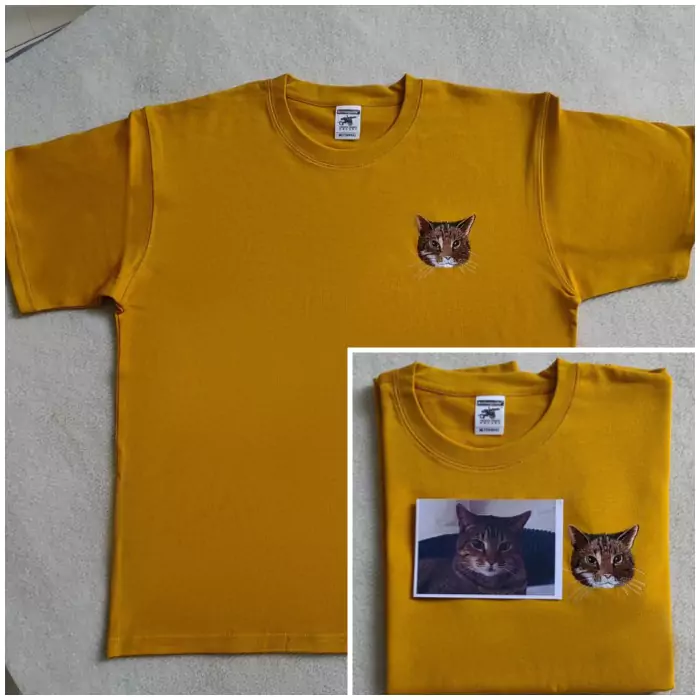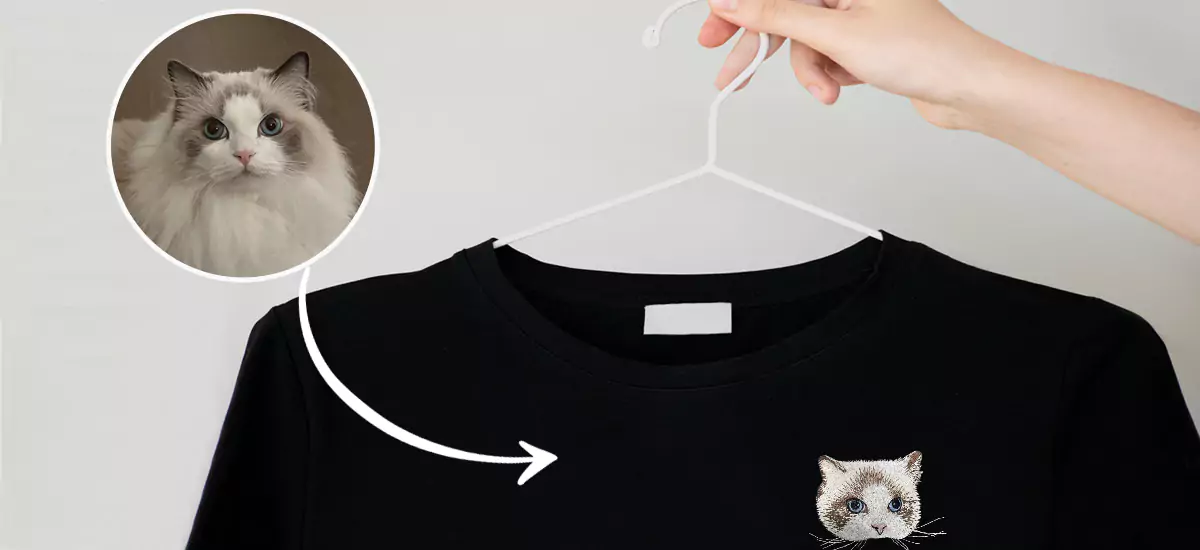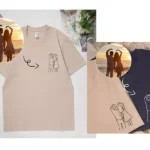Understanding the weight of an embroidered t shirt is fundamental for accomplishing both tasteful allure and pragmatic usefulness. The weight of the shirt influences how the embroidery shows up and feels, as well as how the shirt performs during use and delivery. But, a shirt that is too light could not help complicated embroidery plans, prompting issues, for example, puckering or contortion.
We will investigate different variables that impact the weight of an embroidered t shirt. By understanding these variables, you can arrive at informed conclusions about choosing the right shirt weight for your particular embroidery project. This information guarantees that your plans are excellent, the shirts are agreeable to wear, and the general expense including delivery is reasonable.
Recommended T-Shirt Weights For Different Types Of Embroidery
The right shirt weight guarantees that the embroidery looks great and endures longer without making the texture stretch or contort. Shirt weight is estimated in grams per square meter (GSM) or ounces per square yard (oz/yd²), with heavier loads showing denser, thicker textures. Here is a detailed look at what different shirt loads mean for embroidery :
Heavyweight Shirts
Heavyweight shirt, normally around 200 GSM or more, is the most appropriate for thickly sewn plans. The texture of these shirts is thicker and more hearty, giving areas of strength for a steady base for embroidery. This strength is especially gainful for plans that require a high fasten count, like huge logos or complex examples. The heavier texture can deal with the pressure of various fastens without twisting, extending, or becoming deformed. Moreover, the thicker material assists the embroidery in keeping up with its design and appearance over the long haul, even after various washes.
Medium-Weight Shirts
Medium-weight shirt, by and large around 150 GSM and beneath, offers a decent split of the difference between thickness and solace. They are sufficiently significant to help embroidery however not so thick that they become awkward for the wearer. This makes them ideal for plans that are lighter or less thick. For example, medium-weight shirts are ideal for less complex logos, text, or plans that don’t need a high join count. These shirts are likewise more flexible concerning ordinary wear, giving an equilibrium between strength and solace. While they probably won’t be essentially as steady as heavyweight shirts for exceptionally multifaceted plans, they are reasonable for most standard embroidery projects.
Picking Right Shirt
Choosing the right shirt weight for your embroidery project is fundamental to guarantee both the appearance and life span of the plan. Heavyweight shirts are fantastic for point-by-point, high-fasten plans, offering the fundamental help to keep the embroidery looking sharp. Then again, medium-weight shirts are more adaptable and agreeable, ideal for less difficult, lighter plans that don’t need the additional help of thicker texture. Understanding these distinctions can help in picking the ideal shirt for your particular embroidery needs.

Why T-Shirt Weight Matters
The weight of a shirt is a basic figure in different parts of its utilization, particularly in embroidery and planned operations. Understanding the ramifications of shirt weight can fundamentally improve the results of weaving projects and upgrade delivery operations.
Embroidery Results
The weight of a shirt straightforwardly influences the quality and toughness of embroidery. Heavier shirts give a sturdier and more steady base for mind-boggling embroidery designs. This is because the denser texture can uphold the high fasten counts expected for definite examples and enormous logos. The thickness of heavyweight shirts forestalls normal embroidery issues, for example, puckering, where the texture around the sewed region kinks or assembles because of the pressure of the lines. This guarantees that the weaved configuration stays level and in salvageable shape over the long haul, keeping up with its tasteful allure and toughness even after continued washing and wearing.
Conversely, lighter-weight shirts are milder and more breathable, making them ideal for sensitive embroidery with fewer lines. While they may not give a similar degree of help for weighty sewing, their lightweight nature makes them agreeable to wear, particularly in hotter environments. Picking the fitting shirt weight given the intricacy of the embroidery configuration guarantees that the result is both outwardly engaging and agreeable.
Shipping Costs
The weight of shirts additionally has critical ramifications for delivery costs. Heavier shirts normally weigh more, prompting higher transportation costs, especially for mass requests. Organizations and people who need to deliver huge amounts of shirts can profit from considering the weight of the texture ahead of time. By choosing lighter-weight shirts when fitting, they can decrease delivery costs without settling on the nature of the embroidery for less complex plans. This cost advancement is pivotal for organizations hoping to amplify their net revenues and give practical answers to their clients.
Shirt weight assumes a crucial part in both the nature of embroidery results and the effectiveness of transportation planned operations. By getting it and choosing the fitting shirt weight, one can accomplish prevalent embroidery results and oversee delivery costs.

Factors That Influence The Weight Of An Embroidered T-Shirt
Understanding these components can help in arriving at informed decisions about embroidery projects, guaranteeing the most ideal results regarding the two styles and their usefulness.
Fabric Type
The kind of texture is an essential element influencing the weight of a shirt. Various textures have unmistakable densities, which straightforwardly impact the shirt’s weight when embroidered. For example, cotton is by and large heavier compared with polyester. Cotton filaments are denser and give a thicker vibe, making cotton shirts weigh more than their polyester partners of a similar size and plan. Polyester, being an engineered material, will in general be lighter and less thick, offering an alternate surface and weight. This difference in texture types implies that picking between cotton, polyester, or a mix can fundamentally influence the last weight of the embroidered t shirt. Also, the decision of texture influences the toughness and presence of the embroidery, with heavier textures frequently better supporting complicated plans.
Embroidery Design Complexity
The intricacy of the weaving configuration is another pivotal element. Detailed logos, elaborate examples, and thickly sewn fine art imply that more string is utilized, which can add a lot of weight. Less difficult plans with less fastens negligibly affect the shirt’s weight. While arranging an embroidery project, taking into account the plan intricacy is fundamental, as it influences the appearance as well as the solace and wearability of the shirt. An intensely embroidered area can feel cumbersome and may influence the wrap of the texture.
Use of Stabilizers
Stabilizers are fundamental materials utilized during the embroidery system to help the texture and forestall issues like puckering and contortion. The sort and measure of stabilizer utilized can add to the heaviness of the shirt. There are different kinds of stabilizers, for example, tear-away, remove, and wash-away, each giving various degrees of help and adding fluctuating measures of weight. The decision of stabilizer relies upon the texture and the intricacy of the embroidery plan. For example, a heavier stabilizer may be important for a complex design on a lightweight texture, consequently expanding the general load of the shirt.
Understanding The Overall Weight Distribution In An Embroidered T-Shirt
The weight circulation in an embroidered t-shirt is affected by a few parts, which together add to the general feel and usefulness of the piece of clothing. Understanding what every component means for the complete weight is critical for accomplishing a reasonable and agreeable result.
Fabric Weight Contribution
The base texture weight is the essential variable deciding a shirt’s general weight. Shirts are regularly grouped by their weight per square yard or meter, with normal loads going from 4 to 6 ounces for each square yard (roughly 135 to 200 GSM). The weight of the texture is an impression of its thickness and thickness; heavier textures (more like 6 ounces) are more solid and give a sturdier base to weaving, while lighter textures (around 4 ounces) are gentler and more breathable. The decision of texture weight influences not just the solace and wearability of the shirt but additionally its appropriateness for various sorts of embroidery. For instance, heavier textures are more qualified for multifaceted and densely stitched designs as they offer important help to forestall contortion and puckering.
Thread Contribution
The commitment of embroidery threads to the general load of the shirt can be huge, particularly for perplexing plans with a high join count. Each string utilized in the weaving adds to the all-out weight, and the kind of thread material likewise assumes a part. For instance, polyester threads are by and large lighter than rayon threads, yet both can add significant weight contingent upon the plan’s intricacy. The thickness and thickness of the threads can likewise influence the last weight. Accordingly, while arranging an embroidery project, taking into account the sort and measure of threads is critical for dealing with the shirt’s weight. This is especially significant for bigger or more complex designs, where the additional load from the threads can affect the solace and wearability of the piece of clothing.
Stabilizer Contribution
The sort and measure of stabilizer utilized can altogether impact the general load of the shirt. Remove stabilizers, which stay in the piece of clothing after embroidery, and add an extremely durable load to the shirt. These are normally applied to heavier textures. Then again, tear-away stabilizers are generally eliminated after the embroidery is finished, abandoning just a negligible weight increment. The decision between remove and tear-away stabilizers relies upon the intricacy of the plan and the heaviness of the base texture.
Conclusion
While arranging embroidery projects, consider the weight of t-shirts in both tasteful and useful perspectives. Embroidered t shirts should be chosen in light of the plan’s intricacy and the ideal result. Furthermore, for enterprises, consider the solace of the wearer and the delivery costs, as these elements are critical for maintaining a successful t-shirt business.





